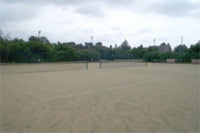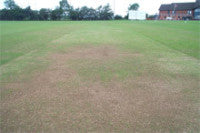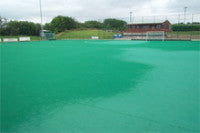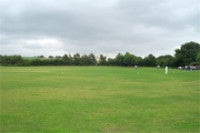Mining to Mowing in ten easy years
Mining to Mowing in ten easy years

I started at Cannock as the Assistant Groundsman, back in 1992, but took over the duties of Head Groundsman from John Ingram when he retired in 1998.
Before I became a Groundsman I had worked for British Coal as a mechanic, but the pit closures and the offer of a nice redundancy package forced me to leave the Industry. I have always worked outside and couldn't envisage working indoors. I thought it was time to change my career and having already serviced the machinery for the sports club as a side deal, decided to make the move and apply when the job became vacant.
Since I took over the Head position about five years ago, I have changed very little, just maybe looked closer at top dressings, seed and fertiliser regimes. Also having a mechanical background enabled me to sort through and weed out poor quality machinery when it came to any purchases.
Since becoming Head Groundsman I have gained my NVQ'S level 4 in Amenity Horticulture and the IOG National Intermediate Diploma in Turf-culture under Alan Lewis's teaching. I am also the ECB county cricket pitch adviser for Staffs.
The club hosts Birmingham Cricket Premier League, which Cannock won the title two years ago. We are also the home of Cannock hockey Club, who play in the National Hockey League and Europe. Our bowls club sometimes hosts county matches, and the players play at a reasonable standard.

In total we maintain an area of 27 acres, comprising of two cricket squares and outfields, (the outfields then get used for mini soccer in the winter), four artificial surfaces, of which one is used for tennis, the others for football and hockey, and of course the one bowls green. There are two of us full time here during the summer to look after all of the sports areas and maintain the car parks and landscaped areas. In the winter, my Assistant, Brian Shaw works with me on a part time basis.
Our equipment isn't marvellous but it's better than at many clubs, we have two tractors, one 36" Dennis mower and the FT510 cassette mower which works a treat on the bowling green, a set of Ransomes gangs and an Auto Certes, SISIS scarifiers and a few other sundries. Apart from the mower re-grinds, because of my background I do most of the other repairs myself, so we get by quite nicely in that respect.
During the summer, the fixtures are coming thick and fast, apart from the club teams, we hire out the facility to local schools and
On the main square, I have 13 tracks for use by the first team and another six for everyone else. The second square has thirteen tracks ready for use.
During any given week, we'll host four weekend cricket matches and between three and five midweek games between the two squares.
When the season finishes, which will be around the second week in September this year, we have to act sharply to get our renovations done in time for the junior football starting. I'll shave the whole square down to a match height and remove the excess grass. I will repair all the ends by hand, returning the correct levels. Then I will hire the Rotorake 600, and give the square a good ripping perhaps four to five passes to clean out the surface, but only between the two popping creases.

The composition of the square consists of a three-inch perimeter drain, which sits below six inches of graded clinker. Above this there is 2 inches of fine clinker, an inch of crushed stone, four inches of medium loam and then five inches of a heavy loam. We top dress with Broughton's County Loam, and have done for all the years that I've worked at the club. One of the benefits of using this is that I've never had a problem growing grass in it.
The outfields don't get their renovations until the end of the football season, usually in the middle of March. Because of the time scale between football finishing and the cricket starting, I sub contract this to local contractors, who vertidrain, seed, and sand dress the areas. Because of the time of year, we will only put on around ten tonnes of sand dressing per pitch. Levels are very good, and we keep on top of divotting during the season so we can keep the sand to a bare minimum. If we had to put on more, it could cause problems with the cricket starting a few weeks later.
We do fence off the squares during the winter, for what good it does; the little monkeys still climb over for the ball.

The other sand based pitches are brushed once if not twice a week with a SISIS zigzag brush or oscillating brush in alternate

When they were installed the club were told that the surfaces had a shelf life of approximately ten years. They are extensively used every day, particularly because we have floodlighting, so they get used right up until 10pm every night. We've had good value from them, but the club are budgeting for replacements in the years to come.
The Bowling Green renovation takes place straight after I put the cricket squares to bed; the green has only been down about five
The Ex-Head Groundsman and I built the upper layers of the green ourselves, but we weren't involved in the base work. It turned out to be a familiar story of someone, knowing someone who could supply some crushed stone. The next thing we knew was a load of broken bricks had been tipped and levelled, and blinded with a local merchants building sand!

The rest of the club facilities include a gym and squash club, plus there are function rooms here and a restaurant.
The club have the opportunity to purchase a further 17 acres of land adjacent to the club, and if we get this then we'll move the junior football over to the new fields and develop this section of the club accordingly.
